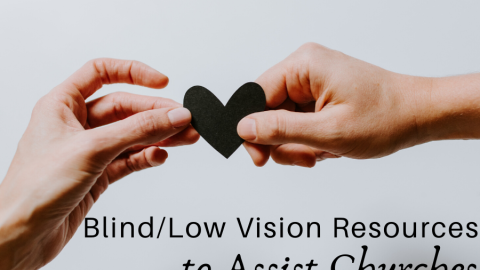Addressing Disempowering Attitudes Toward People Who Are Blind or Have Low Vision
0 comments
217 views

This article is part of the series: How to Create Welcoming Spaces for People Who Are Blind or Have Low Vision. We have collaborated with our friends at the RCA on their online platform, Faithward.
The motto of CRCNA and RCA Disability Concerns is “Everybody belongs, everybody serves.” That includes people who are blind, have low vision, or are sighted. The whole spectrum of gifts and abilities are included in the church and in the kingdom of God. To live into this vision, we must address some disempowering attitudes and stigma that exist, even in the church.
Where do these attitudes come from?
Many people who are blind or have low vision are frustrated about the lack of opportunities to serve and help around their church. Many sighted people have a faulty perception and general misunderstanding of people who are blind or have low vision. Because of this, sighted people inadvertently tend to object when people who are blind or have low vision attempt even the most basic tasks. Such sighted people mean well, but they are putting up barriers because they are often not aware of the skills and capabilities of another person who is blind or has low vision. This is quite problematic, especially when people who are blind or have low vision are willing to share and contribute. As a result, people who are blind or have low vision are disempowered and isolated, feeling rejected or useless.
How can we improve these issues?
There are a couple of suggestions to take into consideration.
The “let me try it” approach could be an effective communication tool for a person who is blind or has low vision. As a first step, it is important for this person to express their own abilities, capabilities, and needs, advocating for themselves as well as the blind/low-vision community. For instance, if someone who is blind or has low vision offers to wash dishes, they can ask the location of the sink, soap, and sponge, and where to place clean dishes. This process could also allow for interaction with sighted people and to build trust.
However, it is fair to say that the “let me try it” approach may not work on many occasions. Church leaders need to teach their congregations to value inclusiveness. Just as “Everybody belongs, everybody serves” suggests, it is crucial that churches exercise leadership to encourage their congregations to interact with people who are blind or have low vision and to discover their gifts and abilities. The goal is to create an environment in which people who are blind or have low vision feel comfortable sharing their gifts, and are therefore able and allowed to serve in their churches and communities along with everyone else. Consider the many ways a person who is blind or has low vision could serve in your church. Here are just a few ideas to get you started:
Again, these are suggestions, not an exhaustive list of possibilities. Allow people who are blind or have low vision to tell you what they can and cannot do, rather than making assumptions on their behalf. And remember: everybody belongs, everybody serves.
Disability Concerns, Church Admin & Finance
Disability Concerns, Church Admin & Finance
Disability Concerns, Training and Education
Disability Concerns
Connect to The Network and add your own question, blog, resource, or job.
Add Your Post
Let's Discuss
We love your comments! Thank you for helping us uphold the Community Guidelines to make this an encouraging and respectful community for everyone.